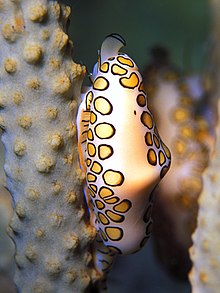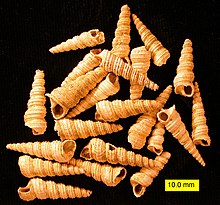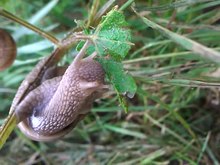Snails
| Snails | ||||||||||||
|---|---|---|---|---|---|---|---|---|---|---|---|---|

Roman snail ( Helix pomatia ) |
||||||||||||
| Systematics | ||||||||||||
|
||||||||||||
| Scientific name | ||||||||||||
| Gastropoda | ||||||||||||
| Cuvier , 1797 |
Screw (Gastropoda, Greek for, gastropods ') of althochdeutsch snahhan , crawl', are a class of animals from the root of the mollusks (Mollusca). It is the most species-rich of the eight recent classes of molluscs and the only one that has also produced terrestrial species. The body size of the adult snails varies from less than 0.5 mm ( Ammonicera rota , family Omalogyridae ) to over 90 cm ( large snail Syrinx aruanus ).
features
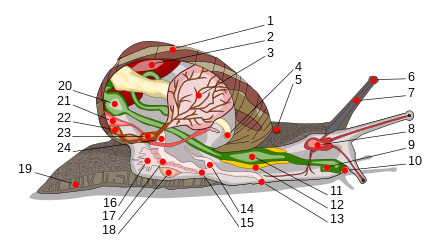
The soft body of a screw consists of the head and foot (collectively Kopffuß hereinafter) and the back lying (dorsal) visceral sac, which is protected by the fabric layer of the shell. Cells in the mantle form the hard shell, which in its basic structure is similar to other mollusc shells, but in contrast to these, is usually wound asymmetrically to one side of the body. Limpets have a shell that is more reminiscent of mussel shells than the "typical" snail shells, with nudibranchs there is no shell at all. In the course of evolution, they have regressed their housing. Clearly recognizable, however, is the jacket bag at the head end, which originally enveloped the screw body in the housing. Schnegel still contain a small rudimentary limestone in the coat bag. Also vitrinidae and Daudebardien carry a significantly housing formed into which they can no longer withdraw completely.
The asymmetry of the snail shell is caused by a developmental process known as torsion , in which the viscera with the mantle rotates to the right, so that the mantle cavity with the respiratory organs that was originally at the back moves forward (so-called gill snails , prosobranchia). To save space, the intestinal sac and thus also the coat and shell then wind together to form the familiar spiral.
In the hind gill snails (Opisthobranchia) a further rotation leads to the fact that the mantle cavity comes back to lie back. The respiratory organs (so-called comb gills or ctenidia) are then regressed secondarily - breathing takes place via other organs (for example the dorsal pinnate gills of the sea-living nudibranchs , nudibranchia).
In some groups of water snails, functional lungs developed after the gills had regressed. This development enabled the lung snails (Pulmonata) to colonize the dry land. The subsequent adaptive radiation and adaptation to the diverse habitats of the dry land resulted in great diversity.
Shell or housing
As snail known shell of the screw, as with the other shell mollusks from lime ( calcium carbonate ), but differs by its asymmetrical spiral turn significantly from this and thus can be distinguished for example from the shell of a shell. While the foundations of the snail shell (the first 1½ turns, known as the primordial thread) are already laid in the egg, the remaining shell grows until the animal is sexually mature. The lime used to build up the shell is ingested with food, but can also be partially loosened from the soil by the sole slime or obtained from other mollusc shells by rasping.
In many groups of snails, a shell lid ( operculum ) closes the mouth opening after the body has been withdrawn . In the case of periwinkles, the shell can thus be sealed at low water and the snail protected against drying out. Also pomatiidae (Pomatiidae) protect themselves with a Operculum against dehydration. But even when the winter is frozen , the snail shell opening is closed until awakening in spring. The shell cover of land snails such as the Roman snail , the so-called epiphragma , is a completely different formation that is thrown off again in spring.
Basically, the winding direction of the snail shell (in most species to the right) is specific for each species and is inherited matroclinically (following the genome of the dam). The exception are deviants in which the shell is twisted in the opposite direction. In the case of Roman snails, these rare specimens are called snail kings .
Movement and Orientation
The body of the snail, which is visible outside the shell of the active animal, is flattened on the ventral side (ventral) to form a sole that is used for locomotion and is consequently called the foot . At the front end, the foot ends in the head, where the snail's feelers are used for orientation. While some species of snail only have two antennae with eyes at the base, the terrestrial pulmonary snails (Stylommatophora) have four antennae, the larger pair of which has one eye each (see Roman snail ). The feelers can only be retracted on these.
While the locomotion of small water snails takes place on an eyelash carpet, the larger and especially the terrestrial species crawl on a slime carpet. For this purpose, glands at the front end of the head secrete mucus, over which they crawl with caterpillar-like movements of the sole. The slime consists of polysaccharides and proteins and is structurally viscous . This means that the mucus is elastic when stretched slightly and becomes fluid when stretched higher. This has been investigated using the slime of the banana snail ( Ariolimax columbianus ). It was found that the mucus changes depending on the stretch between a viscoelastic state with a shear modulus of 100 ... 300 Pa and a liquid with a viscosity of 30 ... 50 poise . The various structural states of the mucous layer migrate underneath the snail as it pushes parts of the foot forward. As a result, snails can even climb smooth surfaces.
While the land snails (Stylommatophora) move with a wave-like sole movement, the land snails, for example, use their two-part foot for a kind of biped walk. The slime remains as a trail of slime, u. a. therefore the movement of the snails is very material and energy intensive.
The foot is extremely flexible and can be used for digging or for forming packets of eggs. Some water snails swim with the help of their feet, others (for example mud snails, Lymnaeidae) can crawl on the underside of the water surface. Limpets (for example Patellidae) can attach themselves to the rock with great force and thus survive the low water almost unmolested, without drying out. At night they break away from their traditional resting place and go looking for food, only to return afterwards. Other species have adapted to a sessile way of life similar to mussels .
nutrition
Among the snails there are herbivores, scavengers and predatory snails , whereby herbivores often also eat carrion, and scavengers often also eat plants, i.e. are omnivores. The ingestion of food takes place with the help of a specialized organ that originated exclusively within the molluscs and is thus unique in the animal kingdom: a toothed rasp tongue ( radula ). Similar to the teeth of other animals, the radula of snails is adapted to the diet: Herbivores have a large number of uniform rasp teeth with which plant material can be rasped off. Predatory species often have fewer, long, dagger-like rasp teeth with which the prey can be held and pieces of meat can be torn out. In the sea-dwelling, predatory cone snails (Conidae), only a few harpoon-shaped teeth are formed with which the prey is injected with a poison and thus paralyzed quickly enough to devour it in one piece.
Reproduction
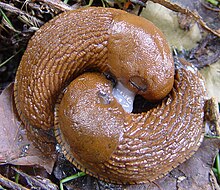
Hermaphroditism
In contrast to most marine snails, some water snails and land snails (Stylommatophora) are exclusively hermaphrodites ( hermaphrodites ): sexual and auxiliary organs are located in a common genital apparatus. While many marine snails develop via free-swimming larvae of the Veliger -type, land snails develop completely within the egg and hatch as young, wired snails.
Some sessile species of worm screw (Vermetidae) multiply by the water current. Other sessile species such as the slippery slug have developed a special hermaphroditism: Depending on the age of the animal, the sexual organs mature so that they fulfill male functions at a young age and female functions at an older age. Since they are stuck and therefore do not move, the offspring prefers to sit on an older animal in the mobile stage of the Veliger larva on the right. After the larva has matured into an adult male snail, it can reproduce with the older female snail and the game can start all over with the offspring.

Love play and mating using the example of the Roman snail
The pairing of the Roman snail takes place after several hours of lovemaking, during which the snails first feel each other with their antennae and then crawl up each other with the soles of their feet. In the course of the love game, a so-called love arrow is used, with which a hormonal secretion is transmitted that improves the reproductive chances of the sperm cells of the donor snail in question. After several mostly unsuccessful attempts at copulation, the actual copulation finally occurs, which in Roman snails takes place simultaneously and alternately, in contrast to other, also hermaphrodite, snail species in which one of the two partners acts as a male and the other as a female. After mating, the two snails stay connected and exchange a packet of seeds, the so-called spermatophore. The sperm cells contained in it are stored in the genital system of the snail in the fertilization pocket. Later, regardless of the pairing, egg cells are created in the gonad (since it also produces the sperm cells, it is called the hermaphrodite gland), which are fertilized with the stored sperm cells. On their hike through the egg ladder to the genital exit, the fertilized egg cells develop into eggs, which in the Roman snail also have a protective egg shell and are deposited in a specially dug laying cave.
Distribution and number of species
The exact number of gastropod species is only available, some of which differ widely. While most estimates assume around 100,000 species of snail, some publications state that there are at most 43,000 species of snail, while other sources give figures of up to 240,000 for marine species alone. However, it is undisputed that snails make up the majority of molluscs. The proportion of land-living snails is estimated to be around 25,000 species. About 260 species of land snails live in Germany.
The reason for the strongly diverging information is obviously the lack of a critical overall revision of the snail taxonomy . More recently, as a result of the use of molecular analysis methods, previously separate species have been grouped together, while others have also been separated into several. Some so far largely untreated habitats - e.g. B. the deep sea or small archipelagos in the Pacific - are also home to numerous as yet unknown species that are awaiting scientific description.
paleontology
The oldest fossil snails date from the early Cambrian approx. 530 million years ago, although the very oldest pieces have not been conclusively clarified whether they really belong to the class of snails. In the Palaeozoic spreads were species of the genus Bellerophon . True freshwater and land lung snails are only known from the Mesozoic ( Jurassic Period ), but snails may well have lived on the mainland or in freshwater in earlier earth periods ( Triassic , late Paleozoic ).
Systematics
In the external system , the closest related classes within the molluscs are not yet clearly identified. The other surviving seven classes of molluscs are shellfish , Scaphopods , solenogastres , caudofoveata , Chitons , Einschaler and cephalopods .
The earlier partial suspected close relationship to the Einschalern (Monoplacophora) is now considered obsolete. The close relationship in the sense of a sister group relationship to either the scaphopods or the cephalopods is discussed . The systematic and primary characteristic of snails (in addition to molecular markers) is the formation of streptoneuria through torsion , the formation of a purely anterior mantle cavity , the formation of only one pair of shell muscles and only one (the right) gonad, and also the formation of a pair of head tentacles .
The internal systematics of snails is still controversial in many respects. There is agreement, however, that the traditional system is considered obsolete as it is not based on monophyletic units (see the second list below). The main groups traditionally used - prosobranchia (hindgill snails), opisthobranchia (hindgill snails ) and pulmonates (lung snails) - describe organizational levels and are only used as descriptive units on an informal basis. The division into land snails, sea snails and field snails, for example by Pedanios Dioskurides , is also out of date.
Modern system
Newer morphological and genetic features are increasingly providing new insights into the relationships between the individual snail groups. A first phylogenetic analysis was published by Ponder & Lindberg (1997). In this system, only strictly monophyletic groups were retained as far as possible , insofar as they were recognizable as such by the authors.
However, as a result of more recent studies, this analysis is also considered to be out of date in places. The “Basommatophora” are now only regarded as an informal group and no longer as a monophyletic taxon; according to Bouchet & Rocroi (2005), they also no longer include the Glacidorboidea. These and many other current findings are not yet presented here because the snail system is still in flux.
Classification of snails according to Ponder & Lindberg (1997)
Snails (Gastropoda) ( Cuvier , 1797)


- Incertæ sedis
- Order Bellerophontida (fossil)
- Order Mimospirina (fossil)
-
Subclass Eogastropoda (Ponder & Lindberg, 1996) (formerly Prosobranchia )
- Order Euomphalida de Koninck 1881 (fossil)
- Superfamily Macluritoidea
- Superfamily Euomphaloidea
- Order Patellogastropoda Lindberg, 1986 (real limpets )
- Subordination Patellina Van Ihering, 1876
- Superfamily Patelloidea Rafinesque , 1815 ( limpets )
- Subordination Nacellina Lindberg, 1988
- Superfamily Acmaeoidea Carpenter, 1857
- Superfamily Nacelloidea Thiele , 1891
- Subordination Lepetopsina McLean, 1990
- Superfamily Lepetopsoidea McLean, 1990
- Subordination Patellina Van Ihering, 1876
- Order Euomphalida de Koninck 1881 (fossil)
-
Subclass Orthogastropoda Ponder & Lindberg, 1996 (formerly Prosobranchia , Opisthobranchia & Pulmonata )
- Incertæ sedis
- Order Murchisoniina Cox & Knight, 1960 (fossil)
- Superfamily Murchisonioidea Koken, 1889
- Superfamily Loxonematoidea Koken, 1889
- Superfamily Lophospiroidea Wenz, 1938
- Superfamily Straparollinoidea Wagner, 2002
- Order Murchisoniina Cox & Knight, 1960 (fossil)
- Grade Subulitoidea Lindström, 1884
- Superorder Cocculiniformia Haszprunar , 1987
- Superfamily Cocculinoidea Dall , 1882
- Superfamily Lepetelloidea Dall , 1882 (deep-sea limpets)
- Paragraph 'Hot Vent Taxa' Ponder & Lindberg, 1997.
- Order Neomphaloida Sitnikova & Starobogatov, 1983
- Superfamily Neomphaloidea McLean, 1981 (hydrothermal snails)
- Superfamily Peltospiroidea McLean, 1989
- Order Neomphaloida Sitnikova & Starobogatov, 1983
- Superorder Vetigastropoda Salvini-Plawen, 1989
- Superfamily Fissurelloidea Flemming, 1822
- Superfamily Haliotoidea Rafinesque , 1815 ( abalone )
- Superfamily Lepetodriloidea McLean, 1988 (hydrothermal snails)
- Superfamily Pleurotomarioidea Swainson, 1840 (slit snails)
- Superfamily Seguenzioidea Verrill, 1884
- Superfamily Trochoidea Rafinesque , 1815 ( top snails )
- Superorder Neritimorpha Koken, 1896 (= Neritopsina)
- Insecure position (all groups only fossil)
- Superfamily Nerrhenoidea Bandel & Heidelberger, 2001
- Superfamily Oriostomatoidea Koken, 1896
- Superfamily Palaeotrochoidea Knight, 1956
- Superfamily Platyceratoidea Hall, 1879
- Order Cyrtoneritomorpha (fossil)
- Order Cycloneritimorpha Frýda, 1998
- Superfamily Helicinoidea Férussac, 1822
- Superfamily Hydrocenoidea Troschel, 1857
- Superfamily Neritoidea Lamarck , 1809
- Superfamily Neritopsoidea Gray, 1847
- Superfamily Symmetrocapuloidea Wenz, 1938
- Insecure position (all groups only fossil)
- Superorder Caenogastropoda Cox, 1960
- Order Architaenioglossa Haller, 1890
- Superfamily Ampullarioidea J. E. Gray , 1824 (including apple snails )
- Superfamily Cyclophoroidea J. E. Gray , 1847 (operculate land snails)
- Order Sorbeoconcha Ponder & Lindberg, 1997
- Subordination Discopoda P. Fischer, 1884
- Superfamily Campaniloidea Douvillé, 1904
- Superfamily Cerithioidea Férussac, 1822
- Suborder Hypsogastropoda Ponder & Lindberg, 1997
- Partial order Littorinimorpha Golikov & Starobogatov, 1975
- Superfamily Calyptraeoidea Lamarck , 1809 (including Calyptraeidae )
- Superfamily Capuloidea J. Fleming, 1822
- Superfamily Pterotracheoidea Rafinesque , 1814 (formerly Heteropoda and Carinarioidea)
- Superfamily Cingulopsoidea Fretter & Patil, 1958
- Superfamily Cypraeoidea Rafinesque , 1815 (including cowries and egg snails )
- Superfamily Ficoidea Meek, 1864 ( Ficidae )
- Superfamily Laubierinoidea Warén & Bouchet, 1990
- Superfamily Littorinoidea (Children), 1834 ( periwinkles , dimple snails , land snails )
- Superfamily Naticoidea Forbes, 1838 ( moon snails )
- Superfamily Rissooidea J. E. Gray , 1847
- Superfamily Stromboidea Rafinesque , 1815 (including Strombidae )
- Superfamily Cassoidea Latreille, 1825 (syn.Tonnoidea Suter, 1913; among others Cassidae , Ranellidae (Cymatiidae) and Personidae )
- Superfamily Trivioidea Troschel , 1863 ( Triviidae )
- Superfamily Vanikoroidea J. E. Gray , 1840
- Superfamily Velutinoidea J. E. Gray , 1840
- Superfamily worm screw (Vermetoidea) Rafinesque , 1815
- Superfamily Xenophoroidea Troschel , 1852 (carrier snails)
- Partial order Ptenoglossa J. E. Gray , 1853
- Superfamily Eulimoidea Philippi , 1853
- Superfamily Janthinoidea Lamarck , 1812
- Superfamily Triphoroidea J. E. Gray , 1847
- Partial order of new snails (Neogastropoda) Thiele , 1929
- Superfamily Buccinoidea ( e.g. Buccinidae , Columbellidae )
- Superfamily Cancellarioidea Forbes & Hanley, 1851
- Superfamily Conoidea Rafinesque , 1815 ( cone snails )
- Superfamily Muricoidea Rafinesque , 1815 (including olive snails )
- Partial order Littorinimorpha Golikov & Starobogatov, 1975
- Subordination Discopoda P. Fischer, 1884
- Order Architaenioglossa Haller, 1890
- Superorder Heterobranchia J. E. Gray , 1840
- Order Heterostropha P. Fischer, 1885
- Superfamily Architectonicoidea JE Gray, 1840
- Superfamily Nerineoidea Zittel , 1873 (fossil)
- Superfamily Omalogyroidea G.O. Sars , 1878
- Superfamily Pyramidelloidea J. E. Gray , 1840
- Superfamily Rissoelloidea J. E. Gray , 1850
- Superfamily Valvatoidea J. E. Gray , 1840
- Superfamily Architectonicoidea JE Gray, 1840
- Order slugs (Opisthobranchia) Milne-Edwards , 1848
- Suborder Cephalaspidea P. Fischer, 1883
- Superfamily Acteonoidea D'Orbigny , 1835
- Superfamily Bulloidea Lamarck , 1801
- Superfamily Cylindrobulloidea Thiele , 1931 (has to be included in the Sacoglossa)
- Superfamily Diaphanoidea Odhner, 1914
- Superfamily Haminoeoidea Pilsbry, 1895
- Superfamily Philinoidea J. E. Gray , 1850
- Superfamily Ringiculoidea Philippi, 1853
- Subordination Sacoglossa Von Ihering, 1876
- Superfamily Oxynooidea H. & A. Adams, 1854
- Subordination sea hare (Anaspidea) P. Fischer, 1883
- Superfamily Akeroidea Pilsbry, 1893
- Superfamily Aplysioidea Lamarck , 1809
- Subordination Notaspidea P. Fischer, 1883
- Superfamily Tylodinoidea J. E. Gray , 1847
- Superfamily Pleurobranchoidea Férussac, 1822
- Suborder Thecosomata Blainville, 1824
- Partial order Euthecosomata Meisenheimer, 1905
- Superfamily Limacinoidea Gray, 1840
- Superfamily Cavolinioidea Gray, 1850
- Partial order Pseudothecosomata Meisenheimer, 1905
- Superfamily Peraclidoidea Gray, 1840
- Superfamily Cymbulioidea Gray, 1840
- Partial order Euthecosomata Meisenheimer, 1905
- Suborder Gymnosomata Blainville, 1824
- Family Clionidae Rafinesque , 1815
- Family Cliopsidae Costa, 1873
- Family Hydromylidae Pruvot-Fol , 1942
- Family Laginiopsidae Pruvot-Fol, 1922
- Family Notobranchaeidae Pelseneer, 1886
- Family Pneumodermatidae Latreille, 1825
- Family Thliptodontidae Kwietniewski, 1910
- Suborder Nudibranch (Nudibranchia) Blainville, 1814
- Partial order Anthobranchia Férussac, 1819
- Superfamily Doridoidea Rafinesque , 1815
- Superfamily Doridoxoidea Bergh, 1900
- Superfamily Onchidoridoidea Alder & Hancock, 1845
- Superfamily Polyceroidea Alder & Hancock, 1845
- Partial order Cladobranchia Willan & Morton, 1984
- Superfamily Dendronotoidea Allman, 1845
- Superfamily Arminoidea Rafinesque , 1814
- Superfamily Metarminoidea Odhner in Franc, 1968
- Superfamily Aeolidioidea J. E. Gray , 1827
- Partial order Anthobranchia Férussac, 1819
- Suborder Cephalaspidea P. Fischer, 1883
- Order lung snails (Pulmonata) Cuvier at Blainville, 1814
- Suborder Systellommatophora Pilsbry, 1948
- Superfamily Onchidioidea Rafinesque , 1815
- Superfamily Otinoidea H. & A. Adams, 1855
- Superfamily Rathouisioidea Sarasin, 1889
- Subordination water pulmonate (Basommatophora) Keferstein in Bronn, 1864
- Superfamily Acroloxoidea Thiele , 1931
- Superfamily Amphiboloidea J. E. Gray , 1840
- Superfamily Chilinoidea H. & A. Adams, 1855
- Superfamily Glacidorboidea Ponder, 1986
- Superfamily Lymnaeoidea Rafinesque , 1815
- Superfamily Planorboidea Rafinesque , 1815
- Superfamily Siphonarioidea J. E. Gray , 1840
- Subordination Eupulmonata Haszprunar & Huber, 1990
- Partial order Acteophila Dall , 1885 (= earlier Archaeopulmonata )
- Superfamily Melampoidea Stimpson, 1851
- Partial order Trimusculiformes Minichev & Starobogatov, 1975
- Superfamily Trimusculoidea Zilch, 1959
- Partial order of land pulmonary snails (Stylommatophora) A. Schmidt, 1856
- Subpart Order Orthurethra
- Superfamily Achatinelloidea Gulick, 1873
- Superfamily Cochlicopoidea Pilsbry, 1900
- Superfamily Partuloidea Pilsbry, 1900
- Superfamily Pupilloidea Turton, 1831
- Sub- part order Sigmurethra
- Superfamily Acavoidea Pilsbry, 1895
- Superfamily Achatinoidea Swainson, 1840
- Superfamily Aillyoidea Baker, 1960
- Superfamily Arionoidea J. E. Gray in Turnton, 1840
- Superfamily Buliminoidea Clessin, 1879
- Superfamily Camaenoidea Pilsbry, 1895
- Superfamily Clausilioidea Mörch, 1864
- Superfamily Dyakioidea Gude & Woodward, 1921
- Superfamily Gastrodontoidea Tryon, 1866
- Superfamily Helicoidea Rafinesque , 1815
- Superfamily Helicarionoidea Bourguignat, 1877
- Superfamily Limacoidea Rafinesque , 1815
- Superfamily Oleacinoidea H. & A. Adams, 1855
- Superfamily Orthalicoidea Albers-Martens, 1860
- Superfamily Plectopylidoidea Moellendorf, 1900
- Superfamily Polygyroidea Pilsbry, 1894
- Superfamily Punctoidea Morse, 1864
- Superfamily Rhytidoidea Pilsbry, 1893
- Superfamily Sagdoidea Pilsbry, 1895
- Superfamily Staffordioidea Thiele , 1931
- Superfamily Streptaxoidea J. E. Gray , 1806
- Superfamily Zonitoidea Mörch, 1864
- ? Superfamily Athoracophoroidea P. Fischer, 1883 (= Tracheopulmonata)
- ? Superfamily Succineoidea Beck, 1837 (= Heterurethra)
- Subpart Order Orthurethra
- Partial order Acteophila Dall , 1885 (= earlier Archaeopulmonata )
- Suborder Systellommatophora Pilsbry, 1948
- Order Heterostropha P. Fischer, 1885
- Superorder Cocculiniformia Haszprunar , 1987
- Incertæ sedis
Traditional systematics
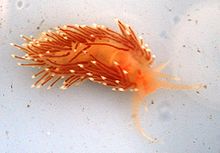
The traditional (and outdated) system, on the other hand, divides snails into the three main groups fore-gill snails (Prosobranchia), lung snails (Pulmonata) and hind- gill snails (Opisthobranchia) with various subgroups. This subdivision is still used in many cases and should therefore be briefly presented here. Some example types are also given.
Modified traditional system
-
Fore gill snails (Prosobranchia)
- Archaeogastropoda - adult snails
- Haliotis sp. - Abalones
- Mikadotrochus sp. - Millionaire snail
- Patella sp. - Limpet
- Pleurotomaria sp. - Slotted belt screw
- Theodoxus fluviatilis - river mermaid snail
- Mesogastropoda - middle snail
- Ampullariidae - apple snails
- Viviparus sp. - Marsh snail
- Littorina sp. - Periwinkle
- Turritella communis - Tower snail
- Hydrobia ulvae - Watt snail
- Crepidula fornicata - slippery slug
- Cypraea sp. - Cowries
- Neogastropoda - new snails
- Murex brandaris - Hercules club
- Nucella lapillus - Northern purple snail
- Buccinum undatum - whelk
- Conus sp. - cone snails
- Madagascaris spec. - Giant snail from Madagascar
-
Allogastropoda
- Architectonica spec. - Sundial snail
- Odostomia sp. - pyramidal snail
- Omalogyra sp. (smallest housing 0.1 mm)
- Archaeogastropoda - adult snails
-
Lung snails (pulmonata)
- Archaeopulmonata - adult lung snails
- Ovatella myosotis - mouse slug
- Carychium spec. - dwarf snail
- Onchidella celtica
- Siphonaria pectinata
- Trimusculus reticulatus
- Basommatophora - water lung snails
- Acroloxus lacustris - pond limpet
- Lymnaea stagnalis - European mud snail
- Galba truncatula - Small pond snail
- Planorbarius corneus - Ramshorn snail
- Ancylus fluviatilis - river cap snail
- Stylommatophora - land snails
- Succinea putris - Amber snail
- Achatina fulica - Large agate snail
- Arion ater - black slug
- Limax cinereo-niger - black snail
- Limax maximus - large snail or tiger snail
- Limax sarnensis - Sarner Schnegel
- Discus rotundatus (OV Müller)
- Discus ruderatus
- Helicella itala - Large heather snail
- Cepaea spec. - Banded snails
- Helix pomatia - Roman snail
- Arianta arbustorum - Spotted snail
- Ariolimax dolichophallus - banana snail
- Archaeopulmonata - adult lung snails
-
Hind gill snails (Opisthobranchia)
-
Cephalaspidea (Bullomorpha) - head shield snails
- Acteon tornatilis
- Retusa obtusa
-
Acochlidiacea
- Microhedyle lactaea
-
Saccoglossa - gastric sacs
- Berthelinia sp.
- Midorigai spec.
-
Thecosomata - sea butterflies
- Criseis acicula - sea butterfly
-
Gymnosomata - oar snails
- Clione limacina
-
Anaspidea
- Aplysia sp. - lumpfish
-
Umbraculomorpha - umbrella snails
- Umbraculum sinicum
-
Pleurobranchmorpha - side gill
- Pleurobranchus californicus
- Nudibranchia - nudibranch
- Doridoidei - star snails
- Polycera faeroensis - Faroese squirrel snail
- Archidoris pseudoargus - sea lemon
- Dendronotoidei - tree snails
- Dendronotus frondosus - Shaggy sapling snail
- Arminodei - furrows worm
- Aelidoidei - thread snails
- Facelina auriculata - thread snail
- Drummond's thread snail - Facelina bostoniensis
- Flabellina affinis - purple thread snail
- Aerola kobaldis - blue flight snail
- Tobacco blanca - White tobacco snail
-
Cephalaspidea (Bullomorpha) - head shield snails
Snails as carriers of parasites
Snails are the basis of food for numerous animals and intermediate hosts for many parasites and pathogens. The species of the genera Biomphalaria and Bulinus are the intermediate hosts for different species of the pair of leeches that cause schistosomiasis (formerly also called schistosomiasis) in humans. These parasites usually live in tropical countries. The amber snail is an intermediate host for the suction worm Leucochloridium paradoxum , which attacks birds. Other species spread plant pathogens, such as many nudibranchs. If human activities lead to an imbalance between snails and their natural predators , mass reproduction can lead to negative effects that are intensified by monocultures in agriculture. Also invasive species are problematic. It is predominantly nudibranchs, such as the Spanish slug ( Arion vulgaris ), which was introduced from Western Europe in the 1970s , which can damage many plants to the point of devouring them, whereas shell snails in many cases prefer wilted food to fresh plants.
Snails as food
- Main article: Snail (food)
Some species of snail, especially Roman snails , have been considered a delicacy since ancient times . They are primarily valued in southern Europe (France, Italy, Spain and Portugal), but there are also traditional southern German snail recipes (for example the Baden snail soup ). Sea snails are also on the menu, for example abalones or limpets as traditional “lapas” dishes on Madeira .
In the meantime the Roman snail has been included in the list of protected animal species according to the Washington Convention on the Protection of Species , because its population had decreased significantly in some areas or they were no longer available. The animals are raised in snail farms and sold in grocery stores.
Related topics
- Snail king , snails with the reverse screw direction of their house
- A butterfly species, Hyposmocoma molluscivora , whose caterpillars specialize in hunting snails, was recently discovered in Hawaii .
literature
- RT Abbott: Compendium of Landshells. A color guide to more than 2,000 of the World's Terrestrial Shells. American Malacologists, Melbourne FL / Burlington MA 1989, ISBN 0-915826-23-2 .
- RT Abbott, SP Dance: Compendium of Seashells. A full-color guide to more than 4,200 of the world's marine shells. Odyssey Publishing, El Cajon CA 1998, ISBN 0-9661720-0-0 .
- Ludger Buse, Dora Godan: Nudibranchs - quietly through the world. Edition Liberacion, Georgsmarienhütte 1999, ISBN 3-923792-44-1 .
- R. Fechter, G. Falkner: Steinbach's natural guide - mollusks. Mosaik-Verlag, Munich 1989.
- MP Kerney, RAD Cameron, JH Jungbluth: The land snails of Northern and Central Europe. Paul Parey Publishing House, Hamburg / Berlin 1983, ISBN 3-490-17918-8 .
- B. Parkinson, J. Hemmen, K. Groh: Tropical Landshells of the World. Verlag Christa Hemmen, Wiesbaden 1987, ISBN 3-925919-00-7 .
- WF Ponder, DR Lindberg: Towards a phylogeny of gastropod molluscs: an analysis using morphological characters. In: Zoological Journal of the Linnean Society. 119, 1997, pp. 83-265.
- A. Robin: Encyclopedia of Marine Gastropods. Verlag ConchBooks, Hackenheim 2008, ISBN 978-3-939767-09-1 .
- S. Sailer: Plants that like or avoid snails, as well as tips to ward off snails. Publishing house Susanne Sailer, Sulz a. N. 2004, ISBN 3-9809229-0-1 .
- V. Wiese: The land snails of Germany. Find - recognize - determine . 2nd Edition. Quelle & Meyer Verlag, Wiebelsheim 2016, ISBN 978-3-494-01686-3 .
- Otto Grunert : The Scaphopods and Gastropods of the German Triassic. A. Vollrath, Erlangen 1898, archive.org .
- Emil Adolf Roßmaessler: Unimagined beauty in despised animals . In: The Gazebo . Issue 46, 1853, pp. 505-507 ( full text [ Wikisource ]).
Web links
- Snails ( Gastropoda ) on weichtiere.at
- A Roman snail's eating sound with anatomical explanations and a spectrogram
Individual evidence
- ↑ Great snail (Syrinx aruanus). Retrieved January 1, 2019 .
- ^ R. Kilias: 12th tribe Mollusca. In: Textbook of Special Zoology. 3. Edition. Volume I, Part 3, G. Fischer, Jena 1982, p. 63 ff.
- ↑ tagesspiegel.de Markus Pfennig, quoted in: Thomas de Padova: Nature's miracle cure: Why do snails slime? , Tagesspiegel on July 10, 2007, accessed on July 18, 2017
- ↑ https://dennylab.stanford.edu/sites/g/files/sbiybj6166/f/denny_gosline_jeb_1980.pdf MW Denny, JM Gosline: The Physical Properties of the Pedal Mucus of the Terrestrial Slug ariolimax columbianus , accessed April 20, 2020
- ↑ weichtiere.at
- ↑ R. Kilias: 10th tribe Mollusca. In: Textbook of Special Zoology. 5th edition. Volume I, Part 3, G. Fischer, Jena 1993, pp. 9–245.
- ↑ Wilfried Westheide , Reinhard Rieger: Special Zoology . Part 1, 2nd edition. Elsevier, 2006.
- ↑ M. Mizzaro-Wimmer, L. Salvini-Plawen: Practical Malacology. Springer, Vienna 2001.
- ↑ W. Appeltans, P. Bouchet, GA Boxshall, K. Fauchald, DP Gordon, BW Hoeksema, GCB Poore, RWM van Soest, S. Stöhr, TC Walter, MJ Costello (eds.): World Register of Marine Species. 2011. Accessed at marinespecies.org on March 7, 2011.
- ↑ G. Falkner, R. Fechter: Molluscs. Mosaic, Munich 1990.
- ^ Noel Morris, John Taylor: Global events and biotic interactions as controls on the evolution of gastropods. In: Stephen J. Culver, Peter F. Rawson: Biotic response to global change: The last 145 million years . Cambridge University Press, 2000.
- ↑ Winston Ponder, David Lindberg: Towards a phylogeny of gastropod molluscs; an analysis using morphological characters. In: Zoological Journal of the Linnean Society. 119, London 1997, pp. 83-265. ISSN 0024-4082
- ↑ Paul Jeffery: Supra Generic classification of class Gastropoda . The Natural History Museum, London, 2001.
- ^ Philippe Bouchet, Jean-Pierre Rocroi: Part 2. Working classification of the Gastropoda. In: Malacologia. 47, Ann Arbor 2005, pp. 239-283 ISSN 0076-2997
- ↑ List of the animals protected under the Washington Convention on the Conservation of Species on a page from "House of Nature" , accessed on September 15, 2012.










